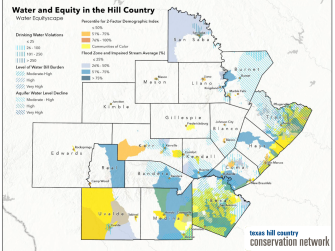Study Reveals Water Disparities in the Texas Hill Country
Flood risk, aquifer decline, drinking water violations, and water affordability concerns are mapped across the region
(Dripping Springs, TX – August 21, 2023) A new study shows the Texas Hill Country’s mounting water challenges are present in low-income communities and communities of color. Commissioned by the Texas Hill Country Conservation Network, the study includes a water ‘equityscape’ that indicates areas of flood risk, aquifer decline, drinking water violations, and water affordability concerns overlap with low-income and historically underrepresented communities.
Drawing on a range of Hill Country demographics, water data, as well as surveys of communities, landowners, and water leaders, the study highlights the region’s increasingly diverse population and identifies imbalances in local leadership and ownership of agricultural operations, among other findings. For example, 74% of county leadership is represented by non-Hispanic White residents, despite the group forming a minority (40%) of the population. Hispanic residents own 12% of agricultural operations despite being the largest ethnic group (46% of the population). Many of the region’s water challenges intersect with these and other findings and have become amplified as water scarcity and risks worsen among Hill Country residents.
In addition, the study’s extensive survey results show residents are concerned about a secure water future, stemming from past experiences of drought and water availability issues, flood risk, rising water costs, and water quality uncertainty. With two-thirds of the region lacking leadership that reflects the communities they serve, addressing these risks could be a significant challenge.
"Our network recognizes the importance of bringing together diverse people and perspectives," said Josh Sendejar, manager of the Texas Hill Country Conservation Network. "The report presents an extraordinary opportunity — to understand the Hill Country's needs and support a path forward for us to create a more inclusive and equitable water culture. To meet this moment and keep with our mission, we must work alongside underserved communities and other stakeholders to improve the quality of life by improving a water-resilient future for everyone."
Download a 4-page summary of the study. Download the full study.

Fig 1. Water Equityscape combining Communities-At-Risk and water challenges in the Texas Hill Country. See p77-80 of full study for more on this map.
With more than 3 million members, Environmental Defense Fund creates transformational solutions to the most serious environmental problems. To do so, EDF links science, economics, law, and innovative private-sector partnerships to turn solutions into action. edf.org
Latest press releases
-
Trump Administration Announces Unlawful Offshore Wind Halt
December 22, 2025 -
Governor Hochul Repeals "100-Foot Rule," Accelerating New York's Clean Energy Future
December 19, 2025 -
Colorado Air Regulators Approve Landfill Methane Standards
December 18, 2025 -
Proposal Would Guarantee Public Access to Air Quality Data
December 18, 2025 -
New Bill Will Help Keep Domestic Manufacturers Competitive
December 17, 2025 -
Satellite Data Shows Colorado Oil & Gas Methane Emissions Dropped as State Rules Took Effect
December 17, 2025










